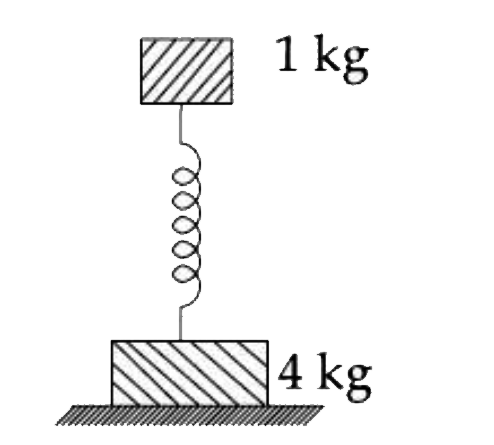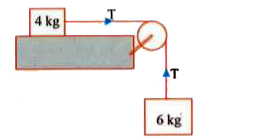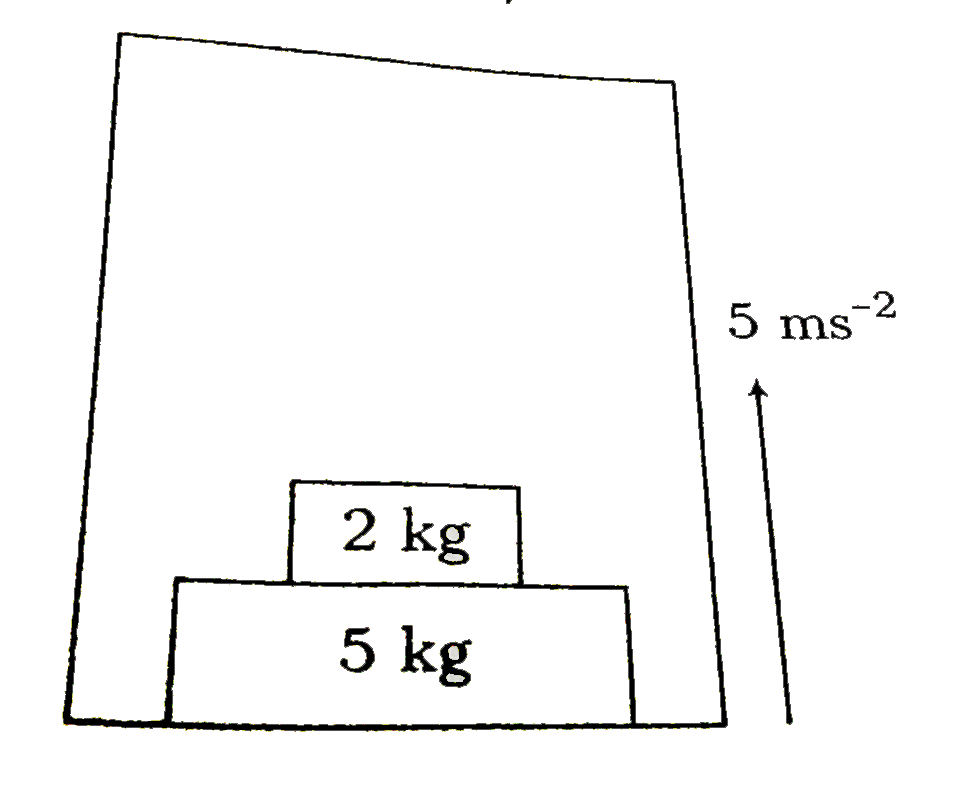Two bodies of masses 1 kg and 4 kg are connected to a vertical spring, as shown in the figure. The smaller mass executes simple harmonic motion of angular frequency 25 rad/s, and amplitude 1.6 cm while the bigger mass remains stationary on the ground. The maximum force exerted by the system on the floor is (take g=10 ms−2)

20 N
10 N
60 N
40 N
The correct Answer is:C
T=2π√mK⇒2πω=2π√mK
or, 125=√1K⇒K=625 Nm−1.
The maximum force exerted by the system on the floor
=Mg+Kx+mg=4×10+625×1.6×10−2+1×10
=40+10+10=60N
Topper's Solved these Questions
- BOOK - DISHA PUBLICATIONCHAPTER - OSCILLATIONS EXERCISE - Exercise-1 : Concept Builder (TOPIC 3: Damped & Forced Oscillations and Resonance)11videos
OSCILLATIONS
- BOOK - DISHA PUBLICATIONCHAPTER - NUCLEIEXERCISE - EXERCISE - 2 (CONCEPT APPLICATOR)30videos
NUCLEI
- BOOK - DISHA PUBLICATIONCHAPTER - PHYSICAL WORLD, UNITS AND MEASUREMENTSEXERCISE - Exercise - 2 : Concept Applicator30videos
PHYSICAL WORLD, UNITS AND MEASUREMENTS
Similar Questions
Two bodies of masses 1 kg and 4 kg are connected to a vertical spring, as shown in the figure. The smaller mass executes simple harmonic motion of angular frequency 25 rad s−1, and amplitude 1.6 cm while the bigger mass remains stationary on the ground. The maximum force exerted by the system on the floor is (take g=10ms−2).
 View Solution
View SolutionA block of mass 5 kg executes simple harmonic motion under the restoring force of a spring. The amplitude and the time period of the motion are 0.1 m and 3.14 s respectively. Fnd the maximum force exerted by the spring on the block.
View Solution
Knowledge Check
- Question 1 - Select One
Two bodies of masses 1 kg and 4 kg are connected to a vertical spring, as shown in the figure. The smaller mass executes simple harmonic motion of angular frequency 25 rad s−1, and amplitude 1.6 cm while the bigger mass remains stationary on the ground. The maximum force exerted by the system on the floor is (take g=10ms−2).
 A20 NB60 NC40 ND10 N
A20 NB60 NC40 ND10 N - Question 2 - Select One
A ball hung from a vertical spring oscillates in simple harmonic motion with an angular frequency of 2.6 rad/s and an amplitude of 0.075m. What is the maximum acceleration of the ball?
A0.13m/s2B0.20m/s2C0.51m/s2D2.6m/s2 - Question 3 - Select One
Two bodies of mass 6 kg and 4 kg are tied to a string as shown in the following figure. If the table is smooth and pulley frictionless, then acceleration of mass 6 kg will be (g=10ms−2)
 A60ms−2B40ms−2C6ms−2D4ms−2
A60ms−2B40ms−2C6ms−2D4ms−2
A block of mass 5 kg executes simple harmonic motion under the restoring force of a spring. The amplitude and the time period of the motion are 0.1 m and 3.14 s respectively. Find the maximum force exerted by the spring on the block.
View SolutionFind the force exerted by 5kg block on floor of lift, as shown in figure. ( Take ,g=10ms−2)
 View Solution
View SolutionA body of mass 20 g connected to a spring of spring constant k, executes simple harmonic motion with a frequency of (5/π) Hz. The value of spring constant is
View SolutionA body of mass 20 g connected to a spring of spring constant k, executes simple harmonic motion with a frequency of (5/π) Hz. The value of spring constant is
View SolutionFind the force exerted by 5kg block on floor of lift, as shown in figure. ( Take ,g=10ms−2)
 View Solution
View Solution
